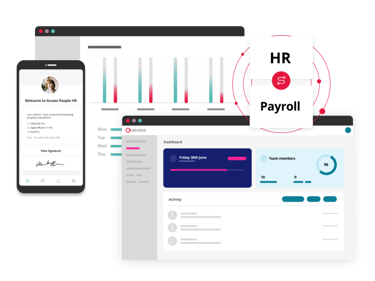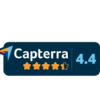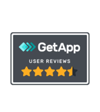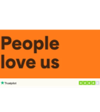Integrated HR and payroll software: overcoming integration challenges

If you’re a small to medium-sized business looking to simplify your HR processes, you will have likely considered the benefits of integrated HR and payroll software.
That’s why integrating payroll and HR software is, in our book, a top consideration.
However, if you’ve built your tech stack over a period of years, you’re likely to be grappling with an overwhelming amount of disparate systems. You may have one tool for attendance, another for time off requests, and a separate platform entirely for payroll processing. The same data is required for different tasks, yet you’re using different tools and systems to obtain it.
Sound familiar? You’re not alone. This is a reality faced by many businesses.
Here at PeopleHR, we know that managing your employees and paying them on time (and correctly) go hand-in-hand, yet we’re also aware of the challenges you might face when integrating two or more functions. In this post, we address those challenges and offer suggestions on how you can overcome them.
What is HR and payroll software integration?
HR and payroll software integration is the process of connecting the work and remuneration data of employees within a business to help better manage a workforce. By integrating both payroll and HR processes, all employment-related documentation is secure and easily accessible, under one platform. With integrated HR and payroll software, users can perform necessary HR functions – such as time and attendance tracking – more efficiently as it communicates with payroll, avoiding costly errors and instances of non-compliance.

What are the key challenges for integrating HR and payroll software?
HR and payroll integrated software can lead to a number of challenges – especially if rushed or done incorrectly.
With that in mind, we’ll now list some of the common challenges to be aware of when thinking about how to integrate hr and payroll.
3 Key challenges for integrating HR and payroll software:
1. Time and resource
The time (and resource) it takes when you consider how to integrate hr and payroll will depend on what system you currently have in place. If you are already working with HR software, the integration of a payroll platform will be simpler. Why? Because you will already have employee information – such as contact details, salary, benefits, allowances and deductions – on a working platform. Therefore, the transfer of this data onto a payroll system will be much easier.
However, if you have no HR software in place at all, it may take time to collate the required data to input into the HR and payroll software. Depending on the current state of your existing process, this could be a fairly simple or complex process – which could be made even more challenging the larger your company is.
To overcome this, we recommend you prepare in advance and ensure a strong plan of action is put in place to reduce impact on the day-to-day running of your business.
If you’re concerned about the time, employee resource and money it costs for integrating a HR and payroll software, we always remind our customers of the long-term benefits to be gained. The time it takes for initial set-up is a small price to pay for the overall efficiencies (and reduction in human error) that you’ll gain.
2. Software incompatibility
Many stand-alone HR software providers will have a payroll integration option as an ‘add-on’. We refer to this as a ‘platform integration’. So, for example, here at PeopleHR, if you’re a user of our HR software, we would effectively ‘turn on’ the payroll platform integration. Since we’d already have your data in place, this would be a very simple process. You may just need to fill in any missing information that doesn’t pull through (like DOB).
The challenge arises if your existing HR system doesn’t have strong integration capabilities. That’s why we always advise people to consider integration (when they’re in the market for HR software) even if you might not need, say, a payroll system, right now. You never know what the future holds. You may expand unexpectedly and require a payroll system to cope with the demands of your growing workforce. This won’t be a stress if your chosen HR software offers a payroll platform integration.
3. New ways of working
Introducing your team to any new software will require them to adapt. For example, a modern HR system will often bring with it the ability for employees to ‘self-serve.’ In other words, individuals will be required to log into a system and input data (such as holiday requests, time and attendance, and so on). However, once employees are used to this new approach, they will quickly realise the benefits to be gained – for example easily requesting holidays (especially if they can do it from the comfort of their mobile device).
If you do decide to go ahead with integrated HR and payroll software, your employees will be even more pleased to know that their time and attendance (which they will have logged themselves) will communicate seamlessly with payroll – meaning no inaccuracies with their payslip!
People often ask about what training is provided when you purchase PeopleHR. Training is included within our four-step implementation process and can be accessed via an e-learning platform. If you purchase a Professional or Enterprise subscription, you get the help of one of our experts to guide you through your new software.
Key takeaway: yes, your team will need to get used to a new way of working which may take initial time and resources – but they will quickly realise the benefit of this new, streamlined process.
Which HR system processes integrate with payroll?
One of the main benefits of integrated HR and payroll software is the way everything can ‘communicate’ which each other. Isn’t it great to know that you’ll have an efficient HR system in place that’ll guarantee everyone gets paid correctly, too?
Processes that can integrate easily with payroll software:
- Applicant tracking system
- Absence management software
- Time and Attendance software
- Performance management software
- Appraisal software
- Ripple® - HR workflow management software
- HR app
- HR Self-service software
The key word here is ‘communication’. When you have an all-encompassing HR platform that works together seamlessly, you’re reducing risk and making everything more efficient. Think how much time you will save… Think how happier your workforce will be…
Let’s now look at further benefits that integrated HR and payroll software can bring.
What are the benefits of integrated HR and payroll software?
Integrated HR and payroll software can provide numerous benefits to businesses of all sizes, from the ability to work more efficiently, to reducing instances of error and non-compliance. When combined, integrated HR and payroll software will help users better manage the HR operations and remuneration data of employees within their business.
With this in mind, we’re going to dig deeper into what we consider to be the top four benefits.
Top 4 benefits of integrated HR and payroll software:
1. Reduces errors
Accidentally inputting a value in the wrong cell in Excel is enough to skew a whole set of data. And whenever data is entered manually, this risk is heightened. If this incorrect data goes unnoticed, it may end up on reports and at this may even lead to fatal business decisions.
Businesses in 2022 should aim to reduce the amount of manual data handling to avoid the above happening, and one way to achieve this is to integrate HR and payroll systems. If the two systems are connected, automated data transfers and updates are enabled, meaning error frequency can be reduced.
Fewer errors don’t just impact a business – they also impact your employees, especially where pay is concerned. With the cost-of-living crisis showing no signs of easing, people will be reliant on a consistent and accurate pay packet each month.
2. Increases employee productivity
If you’re maintaining two (or more) systems and transferring data manually between them, then you will know how time-consuming this can be. It’s clear that this is an unproductive approach – which may lead to unnecessary file duplication with no one knowing which is the most up-to-date version.
One of the biggest benefits of integrated HR and payroll software for SMEs is the instant reduction in data handling and administrative tasks. Automating data entry can free you up to focus on your wider business goals. If you’re a HR professional, this may be introducing a new employee feedback initiative, for example. If you’re a business owner, this could mean building a secure growth plan to future-proof your business.
3. Efficient management of the employee lifecycle
Every employee goes on a journey – from the moment they become aware of your company to the day they leave. Measuring and assessing this process can help drive better (data-driven) business decisions, make your company more attractive to new talent and improve the experience for existing employees.
HR software can help you manage the employee lifecycle in four key ways:
|
Lifecycle stage
|
How HR software can support this |
|
Recruiting |
Most modern HR software includes built-in applicant tracking software features to help you post jobs, gather CVs, screen applicants and set up interviews. |
|
Onboarding |
HR software can house all paperwork related to onboarding and be sent for completion through one email before employee start date. |
|
Development |
HR software makes it easy to understand what motivates employees and what areas they need more support with. With built-in appraisal capabilities, HR software can help create succession paths to nurture and upskill your employees. |
|
Retainment |
HR software makes it easier to track aspects of an employee’s performance and work goals. It also facilitates better communication and provides a better platform for consistent feedback. |
4. Improved data compliance
Since its introduction in 2018, data compliance has put an additional pressure on businesses.
HR software can help reduce this burden by:
- Keeping data secure. With HR software, your data is stored in a single, safe platform that’s data-encrypted and only accessible to specific roles.
- Improving data accuracy. Self-service functionality improves the likelihood of data being kept up-to-date since your employees will be able to easily update any changes in circumstances. If there is any missing data, this will quickly be flagged so you can address it in a timely manner.
- Managing data requests. If anyone requires specific data, you know that it can be easily obtained and exported.
In terms of data compliance, HR software can also help you track employee consent, simplify data deletion, build a culture of privacy and keep your employees informed.
Next steps
Opting for Integrated HR and payroll software is a smart commercial decision for your SME. Combining the two will save time, empower your team and ensure they get paid on time (and correctly).
To recap, the potential challenges (and how to overcome them) are:
- Set up time and use of resource. This can be controlled, providing proper planning is in place.
- Software incompatibility. If you’re working with a system that has poor integration capabilities, you may be required to purchase a new HR and payroll system.
- New ways of working. Your team will need initial training and support for them to use the software correctly.
However, these challenges are minor when you consider the efficiencies your business will gain. If HR and payroll software interests you, watch our four-minute demo. If, after watching, you feel like we’re a good fit for each other, get in touch. We’d love to hear from you.
Related resources
We are trusted by experts














































